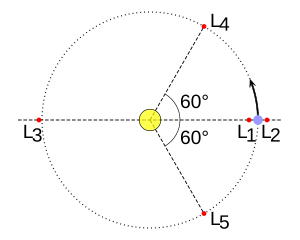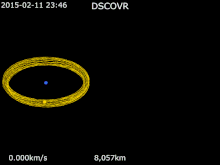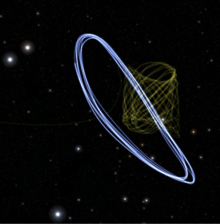

This is a list of known objects which occupy, have occupied, or are planned to occupy any of the five Lagrange points of two-body systems in space.

L1 is the Lagrange point located approximately 1.5 million kilometers from Earth towards the Sun.

L2 is the Lagrange point located approximately 1.5 million kilometers from Earth in the direction opposite the Sun. Spacecraft at the Sun–Earth L2 point are in a Lissajous orbit until decommissioned, when they are sent into a heliocentric graveyard orbit.[citation needed]


L3 is the Sun–Earth Lagrange point located on the side of the Sun opposite Earth, slightly outside the Earth's orbit. Direct communication with spacecraft in this position is blocked by the sun.
L4 is the Sun–Earth Lagrange point located close to the Earth's orbit 60° ahead of Earth.
L5 is the Sun–Earth Lagrange point located close to the Earth's orbit 60° behind Earth.
Asteroids in the L4 and L5 Sun–Mars Lagrangian points are sometimes called Mars trojans, with a lower-case t, as "Trojan asteroid" was originally defined as a term for Lagrangian asteroids of Jupiter. They may also be called Mars Lagrangian asteroids.
Source: Minor Planet Center [1]
Asteroids in the L4 and L5 Sun–Jupiter Lagrangian points are known as Jupiter Trojan asteroids or simply Trojan asteroids.
Minor planets in the L4 and L5 Sun–Neptune Lagrangian points are called Neptune trojans, with a lower-case t, as "Trojan asteroid" was originally defined as a term for Lagrangian asteroids of Jupiter.
Data from: Minor Planet Center [2]
Color key:
Unflown or planned mission
Mission en route or in progress (including mission extensions)
Mission at Lagrangian point completed successfully (or partially successfully)
| Mission | Lagrangian point | Agency | Description |
|---|---|---|---|
| International Sun–Earth Explorer 3 (ISEE-3) | Sun–Earth L1 | NASA | Launched in 1978, it was the first spacecraft to be put into orbit around a libration point, where it operated for four years in a halo orbit about the L1 Sun–Earth point. After the original mission ended, it was commanded to leave L1 in September 1982 in order to investigate comets and the Sun.[21] Now in a heliocentric orbit, an unsuccessful attempt to return to halo orbit was made in 2014 when it made a flyby of the Earth–Moon system.[22][23] |
| Advanced Composition Explorer (ACE) | Sun–Earth L1 | NASA | Launched 1997. Has fuel to orbit near L1 until 2024. Operational as of 2019[update].[24] |
| Deep Space Climate Observatory (DSCOVR) | Sun–Earth L1 | NASA | Launched on 11 February 2015. Planned successor of the Advanced Composition Explorer (ACE) satellite. |
| LISA Pathfinder (LPF) | Sun–Earth L1 | ESA, NASA | Launched one day behind revised schedule (planned for the 100th anniversary of the publication of Einstein's General Theory of Relativity), on 3 December 2015. Arrived at L1 on 22 January 2016.[25] LISA Pathfinder was deactivated on 30 June 2017.[26] |
| Solar and Heliospheric Observatory (SOHO) | Sun–Earth L1 | ESA, NASA | Orbiting near L1 since 1996. Operational as of 2020[update].[27] |
| WIND | Sun–Earth L1 | NASA | Arrived at L1 in 2004 with fuel for 60 years. Operational as of 2019[update].[28] |
| Wilkinson Microwave Anisotropy Probe (WMAP) | Sun–Earth L2 | NASA | Arrived at L2 in 2001. Mission ended 2010,[29] then sent to solar orbit outside L2.[30] |
| Herschel Space Telescope | Sun–Earth L2 | ESA | Arrived at L2 July 2009. Ceased operation on 29 April 2013; will be moved to a heliocentric orbit.[31][32] |
| Planck Space Observatory | Sun–Earth L2 | ESA | Arrived at L2 July 2009. Mission ended on 23 October 2013; Planck has been moved to a heliocentric parking orbit.[33] |
| Chang'e 2 | Sun–Earth L2 | CNSA | Arrived in August 2011 after completing a lunar mission before departing en route to asteroid 4179 Toutatis in April 2012.[12] |
| ARTEMIS mission extension of THEMIS | Earth–Moon L1 and L2 | NASA | Mission consists of two spacecraft, which were the first spacecraft to reach Earth–Moon Lagrangian points. Both moved through Earth–Moon Lagrangian points, and are now in lunar orbit.[34][35] |
| WIND | Sun–Earth L2 | NASA | Arrived at L2 in November 2003 and departed April 2004. |
| Gaia Space Observatory | Sun–Earth L2 | ESA | Launched 19 December 2013.[36] Operational as of 2020[update].[37] |
| Chang'e 5-T1 Service Module | Earth–Moon L2 | CNSA | Launched on 23 October 2014, arrived at L2 halo orbit on 13 January 2015.[2] |
| Queqiao | Earth–Moon L2 | CNSA | Launched on 21 May 2018, arrived at L2 halo orbit on June 14 for Chang'e 4 mission.[38] Queqiao is the first ever communication relay and radio astronomy satellite at operating its location.[39] |
| Spektr-RG | Sun–Earth L2 | IKI RAN DLR |
Launched 13 July 2019. Roentgen and Gamma space observatory. Operational as of June 2020.[40] |
| James Webb Space Telescope (JWST) | Sun–Earth L2 | NASA, ESA, CSA | Launched on 25 December 2021, arrived at L2 point on 24 January 2022. Operational as of 2022.[41] |
| Euclid | Sun–Earth L2 | ESA, NASA | Launched on 1 July 2023, arrived at L2 point on 28 July 2023. Currently in testing phase as of September 2023.[42] |
| Aditya-L1 | Sun–Earth L1 | ISRO | Launched on 2 September 2023[43] and was successfully inserted into an orbit about Sun-Earth L1 point on 6 January 2024.[44] |
| Mission | Lagrangian point | Agency | Description |
|---|---|---|---|
| "Lunar Far-Side Communication Satellites" | Earth–Moon L2 | NASA | Proposed in 1968 for communications on the far side of the Moon during the Apollo program, mainly to enable an Apollo landing on the far side—neither the satellites nor the landing were ever realized.[45] |
| Space colonization and manufacturing | Earth–Moon L4 or L5 | — | First proposed in 1974 by Gerard K. O'Neill[46] and subsequently advocated by the L5 Society. |
| EQUULEUS | Earth–Moon L2 | University of Tokyo, JAXA | 6U CubeSat, launch planned in 2021 as a secondary payload onboard SLS Artemis 1.[47] |
| DESTINY+ | Earth–Moon L2 | JAXA | JAXA "Medium-Sized Focused Mission"; launch planned for 2025.[48] |
| Exploration Gateway Platform | Earth–Moon L2[49] | NASA | Proposed in 2011.[50] |
| Nancy Grace Roman Space Telescope (WFIRST) | Sun–Earth L2 | NASA, USDOE | Launch planned for 2026.[51] |
| LiteBIRD | Sun–Earth L2[52] | JAXA, NASA | JAXA's next "Strategic Large Mission"; launch planned for 2032.[53][54] |
| Interstellar Mapping and Acceleration Probe (IMAP) | Sun–Earth L1 | NASA | Planned for launch in early 2025. |
| Space Weather Follow On - Lagrange 1 (SWFO-L1) | Sun–Earth L1 | NOAA | Planned for launch in early 2025 as a rideshare to IMAP. |
| Planetary Transits and Oscillations of stars (PLATO) | Sun–Earth L2 | ESA | Planned for launch in 2026 for an initial six-year mission.[55] |
| Space Infrared Telescope for Cosmology and Astrophysics (SPICA) |
Sun–Earth L2 | JAXA, ESA, SRON | As of 2015[update], awaiting approval from both Japanese and European side, launch proposed for 2032.[56] |
| Advanced Telescope for High Energy Astrophysics (ATHENA) |
Sun–Earth L2 | ESA | Launch planned for 2035.[57] |
| ESA Vigil | Sun–Earth L5 | ESA | Observatory for early warning of increased solar activity. Launch planned for 2029. |
| Sun Chaser[58] | Sun–Earth L4 | — | Observatory for early warning of solar particle events. Early proposal phase. |
| Spektr-M | Sun–Earth L2 | Roscosmos | Possible launch after 2030.[59] |
|
Exploration of the Solar System
| |||||
|---|---|---|---|---|---|
| |||||
| Exploration of |
| ||||
| Artificial objects |
| ||||
| Lists |
| ||||
| |||||
|
Spaceflight lists and timelines
| |||||||||||||||||
|---|---|---|---|---|---|---|---|---|---|---|---|---|---|---|---|---|---|
| |||||||||||||||||
| General |
| ||||||||||||||||
| Human spaceflight |
| ||||||||||||||||
| Solar System exploration |
| ||||||||||||||||
| Earth-orbiting satellites |
| ||||||||||||||||
| Vehicles |
| ||||||||||||||||
| Launches by rocket type |
| ||||||||||||||||
| Launches by spaceport |
| ||||||||||||||||
| Agencies, companies and facilities |
| ||||||||||||||||
| Other mission lists and timelines |
| ||||||||||||||||